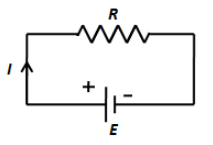
A battery of emf 10V and internal resistance \[3\,\Omega \] is connected to a resistor. The current in the circuit is 0.5A. The terminal voltage of the battery when the circuit is closed is
A. 10 V
B. 0 V
C. 8.5 V
D. 1.5 V
Answer
552k+ views
Hint: Using Kirchhoff’s voltage, express the current in the circuit and therefore, determine the value of resistance. Using Ohm’s law, express the voltage across the resistance. The voltage across the resistance is the terminal voltage of the battery.
Formula used:
Ohm’s law, \[V = IR\],
where, V is the voltage, I is the current and R is the resistance.
Complete step by step answer:
We have given that a supply of emf 10V is given to the circuit containing a resistor of \[3\,\Omega \]. The current in the circuit is 0.5A. The above mentioned circuit will look like as shown in the figure below.

Let the internal resistance of the battery is r. Applying Kirchhoff’s voltage law in the closed loop, we get,
\[E - Ir - IR = 0\]
\[ \Rightarrow E = I\left( {r + R} \right)\]
\[ \Rightarrow I = \dfrac{E}{{r + R}}\]
This is the magnitude of the current that will flow through the circuit.
Rearranging the above equation for r, we get,
\[r + R = \dfrac{E}{I}\]
\[ \Rightarrow R = \dfrac{E}{I} - r\]
Substituting 10V for E, 0.5A for I and \[3\,\Omega \] for r in the above equation, we get,
\[R = \dfrac{{10}}{{0.5}} - 3\]
\[ \Rightarrow R = 17\,\Omega \]
Now, we can express the terminal voltage in the circuit as voltage drop across the resistance R.
\[V = IR\]
Substituting 0.5A for I and \[17\,\Omega \] for R in the above equation, we get,
\[V = \left( {0.5} \right)\left( {17} \right)\]
\[ \therefore V = 8.5\,{\text{V}}\]
Thus, the terminal voltage of the battery when the circuit is closed is equal to 8.5 V.
So, the correct answer is option C.
Note: While using Kirchhoff’s law, if there is drop in the voltage across the component of the circuit, the voltage should be taken as negative and if there is addition of the voltage. The internal resistance of the battery is negligible and therefore, we often neglect its value. The direction of the conventional current in the circuit is always from the positive terminal of the battery towards its negative terminal.
Formula used:
Ohm’s law, \[V = IR\],
where, V is the voltage, I is the current and R is the resistance.
Complete step by step answer:
We have given that a supply of emf 10V is given to the circuit containing a resistor of \[3\,\Omega \]. The current in the circuit is 0.5A. The above mentioned circuit will look like as shown in the figure below.

Let the internal resistance of the battery is r. Applying Kirchhoff’s voltage law in the closed loop, we get,
\[E - Ir - IR = 0\]
\[ \Rightarrow E = I\left( {r + R} \right)\]
\[ \Rightarrow I = \dfrac{E}{{r + R}}\]
This is the magnitude of the current that will flow through the circuit.
Rearranging the above equation for r, we get,
\[r + R = \dfrac{E}{I}\]
\[ \Rightarrow R = \dfrac{E}{I} - r\]
Substituting 10V for E, 0.5A for I and \[3\,\Omega \] for r in the above equation, we get,
\[R = \dfrac{{10}}{{0.5}} - 3\]
\[ \Rightarrow R = 17\,\Omega \]
Now, we can express the terminal voltage in the circuit as voltage drop across the resistance R.
\[V = IR\]
Substituting 0.5A for I and \[17\,\Omega \] for R in the above equation, we get,
\[V = \left( {0.5} \right)\left( {17} \right)\]
\[ \therefore V = 8.5\,{\text{V}}\]
Thus, the terminal voltage of the battery when the circuit is closed is equal to 8.5 V.
So, the correct answer is option C.
Note: While using Kirchhoff’s law, if there is drop in the voltage across the component of the circuit, the voltage should be taken as negative and if there is addition of the voltage. The internal resistance of the battery is negligible and therefore, we often neglect its value. The direction of the conventional current in the circuit is always from the positive terminal of the battery towards its negative terminal.
Recently Updated Pages
Master Class 11 Accountancy: Engaging Questions & Answers for Success

Master Class 11 Science: Engaging Questions & Answers for Success

Master Class 11 Business Studies: Engaging Questions & Answers for Success

Master Class 11 English: Engaging Questions & Answers for Success

Master Class 11 Computer Science: Engaging Questions & Answers for Success

Master Class 9 General Knowledge: Engaging Questions & Answers for Success

Trending doubts
Which are the Top 10 Largest Countries of the World?

Draw a labelled sketch of the human eye class 12 physics CBSE

State the principle of an ac generator and explain class 12 physics CBSE

Differentiate between insitu conservation and exsitu class 12 biology CBSE

Sketch the electric field lines in case of an electric class 12 physics CBSE

Give 10 examples of unisexual and bisexual flowers




